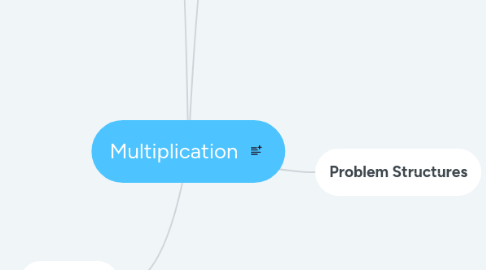
1. Instructional Practices
1.1. Contextual Problems
1.1.1. based on students' experiences
1.1.2. builds on known context
1.1.3. incorporate multiple strategies
1.2. Model-Based Problems
1.2.1. array
1.2.2. manipulatives
2. Properties
2.1. Commutative
2.1.1. numbers can be multiplied in any order
2.2. Associative
2.2.1. when multiplying pairs of numbers order does not matter
2.3. Zero
2.3.1. a number multiplied by zero is zero
2.4. Identity
2.4.1. a number multiplied by one is itself
2.5. Distributive
2.5.1. either factor in a multiplication problem can be decomposed into two or more parts - the split parts can then be multiplied and added to one another
3. Problem Structures
3.1. Equal-Group
3.1.1. sometimes reffered to as repeated addition
3.1.1.1. can be important connection for new learners
3.1.1.2. angle depreciates upon introduction to fractions
3.1.2. number and size groups are known
3.1.2.1. when number or size is unknown it's division
3.2. Comparison
3.2.1. 2 sets or groups
3.2.1.1. one group is particular multiple of other
3.2.1.2. 3 possibilities of unknown
3.2.1.2.1. product
3.2.1.2.2. group size
3.2.1.2.3. number of groups
3.3. Area and Array
3.3.1. (area) product is different type of unit from 2 factors
3.3.1.1. factors are one-dimensional but product is two-dimensional
3.3.2. (array) equal-group problem model
3.4. Combination
3.4.1. number of possible pairings that can be made between two or more sets
4. Multistep Problems
4.1. can be involved in all operations
4.2. give students a one-step problem to solve before allowing them to create a second problem
4.2.1. make a hidden question and repeat approach
4.2.2. students creating story problems is an effective formative assessment
